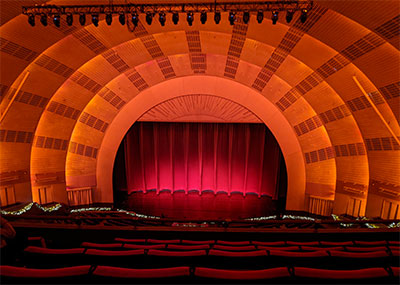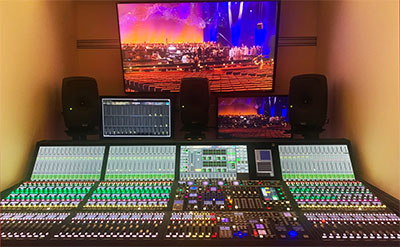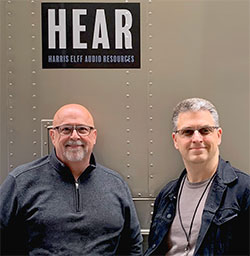![]() When John Harris and Jody Elff recruited to engineer the recording of CBS’ One Last Time: An Evening with Tony Bennett and Lady Gaga shortly before Bennett announced his retirement from live performance, they immediately understood the musical and cultural significance of the event.
When John Harris and Jody Elff recruited to engineer the recording of CBS’ One Last Time: An Evening with Tony Bennett and Lady Gaga shortly before Bennett announced his retirement from live performance, they immediately understood the musical and cultural significance of the event.
‘We knew this would be a big show on so many levels,’ says Harris. ‘We had to capture magic in a bottle.’
Co-founders of Harris-Elff Audio Resources (HEAR), Harris and Elff recorded two sold-out performances at New York’s at Radio City Music Hall using the Gemini mobile – and their 70-plus years combined experience. Executive Producer and Director Alex Coletti decided to bring HEAR onboard from the earliest stages of his planning. ‘Whenever I get the call for a show like this, I know that people aren’t just calling me,’ he says. ‘They know that, with me, comes a team of top-notch collaborators.’
 Coletti’s experience working with Harris goes back to Tony Bennett’s MTV Unplugged performance from 1994, which Harris engineered. The album resulting from that performance went on to win two Grammy Awards. More recently, Coletti worked with Elff on the Words and Music podcast series for Audible, leveraging HEAR’s remote mixing capabilities. ‘John and Jody have an ingenious system which allows us to record remotely and even mix artists live remotely,’ Coletti says. ‘I love that their heads are going into those new endeavours and pushing the technology.’
Coletti’s experience working with Harris goes back to Tony Bennett’s MTV Unplugged performance from 1994, which Harris engineered. The album resulting from that performance went on to win two Grammy Awards. More recently, Coletti worked with Elff on the Words and Music podcast series for Audible, leveraging HEAR’s remote mixing capabilities. ‘John and Jody have an ingenious system which allows us to record remotely and even mix artists live remotely,’ Coletti says. ‘I love that their heads are going into those new endeavours and pushing the technology.’
For One Last Time, working with the HEAR team helped bring stability to the audio aspects of the project. ‘This is a TV project, but it’s music driven,’ Coletti says. ‘It really is about the sound and the performance and capturing that. With so many variables in the world at the time we didn’t want to have to worry about anything else, and there was never a question we were working with the right people in John and Jody.’
One Last Time saw both artists backed by a full orchestra and their respective bands – which included two drummers, two bass players, two keyboard players, saxophone, trumpet and guitar.
‘We were looking at 50 channels of orchestra, 60 channels of band, and another 40 channels of audience and production elements,’ Elff explains. ‘It’s important to manage all that signal flow so that, when we hand off that 150-channel Pro Tools session to the postproduction team, everything is where it needs to be in the timeline and it sounds good.’
‘The scale of what Gemini can do as a piece of technology is really spectacular and it’s a wonderful tool,’ Harris adds. ‘It’s the most powerful vehicle of its kind in America.’
To record a special performance by iconic artists in a storied location, Harris and Elff took pains to capture the energy of the sold-out crowd. ‘The sound of Radio City is a really important part of this,’ says Harris. ‘It can be great, but it can also be a challenging room.’ Harris turned to his experience to help inform his choices on microphone placement. ‘I’ve probably done 50 recordings in there, so I know exactly where to put the microphones to capture the sound of the room and the crowd. You get an amazing connection to the people in the audience and a sense of their connection to the artists.’ Working with veteran engineer Al Centrella, the team covered the room from every perspective to ensure solid tools for the final mix.
This audio capture relied on a selection of DPA Microphones of for the orchestral recording.
‘The audience was full of love for Tony Bennett, and it was a powerful couple of nights of music,’ says Elff. ‘We had DPA mics all over the orchestra – our older 4021 Compact Cardioid Condensers [today known as the 4011ES] on the piano, 4061 Omnidirectional Miniatures on the violins and violas, and 4099 Instrument Mics on all brass, woodwinds and strings, including harp, as well as on the soloing sax and trumpet. As expected, all the DPA mics sounded great.’
 During the two performances, Elff was feeding his mixes to Harris, who was mixing the bands and vocals. ‘I sent my stems to John for him to blend,’ Elff explains. ‘It was not a live broadcast, but we were making a stereo reference mix that would later be used during the video edit. I had the orchestra under my fingers with 40 or 50 channels of inputs, with DPA arranged throughout. It was fantastic to have DPA’s level of fidelity and unrivalled level of clarity and isolation in the very large hall, which had a lot of sound reinforcement and 6,000 adoring fans. The DPA mics allowed me to create a beautiful, clean, orchestral mix that worked really well for the recording. I also sent mixed stems of the orchestra mics back to the stage to be used in the performers’ in-ear monitors. These performances were remarkably touching, and the DPA microphones helped showcase Tony’s legacy as one of all-time greats.’
During the two performances, Elff was feeding his mixes to Harris, who was mixing the bands and vocals. ‘I sent my stems to John for him to blend,’ Elff explains. ‘It was not a live broadcast, but we were making a stereo reference mix that would later be used during the video edit. I had the orchestra under my fingers with 40 or 50 channels of inputs, with DPA arranged throughout. It was fantastic to have DPA’s level of fidelity and unrivalled level of clarity and isolation in the very large hall, which had a lot of sound reinforcement and 6,000 adoring fans. The DPA mics allowed me to create a beautiful, clean, orchestral mix that worked really well for the recording. I also sent mixed stems of the orchestra mics back to the stage to be used in the performers’ in-ear monitors. These performances were remarkably touching, and the DPA microphones helped showcase Tony’s legacy as one of all-time greats.’
To keep tabs on the incoming audio while creating a production mix on the fly, Harris and Elff used Gemini’s dual control rooms to divide the labour – Elff handled the orchestral inputs on his console, delivering submixes to Harris in the forward control room via Gemini’s advanced routing capabilities, where Harris combined them with the band and vocals to create a working mix.
According to Elff, the compact form-factor of the DPA mics also benefitted the production. ‘I’m pleased that the mics are so discreet,’ he says. ‘When there’s a lot of people on the stage, like we had for these performances, using 4061s and 4099s gives the audience the ability to experience the music without a forest of microphone stands obscuring their view of the musicians, either in the hall or on-camera. I think it’s important for the audience not to be distracted by all the technology. They’re not thinking about the microphones, they’re just watching the musicians play, listening to the music and thinking about how good it sounds.’
‘John and I complement each other nicely in terms of our collective professional experience,’ says Elff. ‘You can’t overstate John Harris’s impact on live music broadcast over the past 30 years, while I’ve spent a lot of my time in concert halls working with classical and world music.’
Harris notes that dividing the work this way helps to deliver the best possible result. ‘To each take a piece of the show and give it our full attention was a pleasure.’
The mix created live by Harris and Elff in Gemini was critical for jumpstarting the postproduction process. ‘The mix that we made on the fly gets printed to the camera cuts and that’s the mix that everyone uses during the first three months or so of postproduction until the final mixes are done,’ Elff says. ‘So it was important that we gave them a mix of very good quality to work with, and that’s exactly what we’re equipped to do.’
 The final music mix was handled by award-winning mix engineer Dae Bennett, Tony Bennett’s son, who was also a producer on One Last Time. HEAR’s recordings gave him the raw material he needed to deliver the sound of the show for broadcast. ‘Being raised by my father, quality was always the top issue, because quality is what lives on in art,’ he says. ‘As an engineer myself, it’s always hard to hand off a big chunk of a project to somebody else, so when I’m producing and mixing these shows it’s great to have a team that you can trust. And John and Jody are top notch.’
The final music mix was handled by award-winning mix engineer Dae Bennett, Tony Bennett’s son, who was also a producer on One Last Time. HEAR’s recordings gave him the raw material he needed to deliver the sound of the show for broadcast. ‘Being raised by my father, quality was always the top issue, because quality is what lives on in art,’ he says. ‘As an engineer myself, it’s always hard to hand off a big chunk of a project to somebody else, so when I’m producing and mixing these shows it’s great to have a team that you can trust. And John and Jody are top notch.’
Bennett’s faith in HEAR freed him to give his attention to other critical aspects of his job. ‘I can focus on listening to the performance itself, taking notes on the different takes and such during the show for my edits,’ he says. ‘And I can do that because I know that John and Jody are handling things correctly.’
With One Last Time drawing on two nights’ performances, getting the set-up right from the outset was critical. ‘My father only performs live, even in the studio,’ Dae Bennett says. ‘So if we want to mix takes at all, I have to make cuts across the whole session. We needed everything to be totally consistent between the two nights for that to be possible here. Steady, clean, and buzz-free with no intermittency. Without that any editing becomes almost impossible. That’s where the trust factor with HEAR comes in.’
As busy as Harris and Elff were during the performance, they each took some time to let the magnitude of the cultural moment sink in. ‘I walked out on the stage just before the artists went on and could see every luminary from every age group and every part of society out there,’ Harris says. ‘Sometimes you can feel chills going through your body, not only from the music but from our role in it. That’s a great part about what we do.’ Elff points out that he felt being asked to handle this critical recording validated HEAR’s reputation as the industry leader in high-leverage audio capture. ‘The confidence placed in us by everyone involved was enormous. And we know that we’re able to live up to it.’
For Coletti, HEAR’s presence helped create an environment where everyone on the team could do their best work. ‘Working with HEAR provides the utmost comfort for me, for the artists and for the rest of the team. They’re so self-sufficient and so together that the audio becomes something you never worry about. It’s a big warm safety blanket that you wrap yourself up in, and it helps you to succeed.’
‘One Last Time: An Evening with Lady Gaga and Tony Bennett’ aired in the US November 2021 and in the UK in January 2022, and is currently available to stream on Paramount+.